Planning to spend 10 days in Spain?
Spain is one of the most vibrant countries in Europe and there is much to see and experience – from incredible architecture, grand churches, historic monuments, picturesque towns, flamenco, sangria, tapas (soooo many tapas)….the list goes on and on.
You’re definitely not going to do it all when trying to see Spain in 10 days (not even close!), but it is a good amount of time to see some of its most iconic cities and get a good feel for them. However, you’re going to have to prioritize.
When I was planning my Spain trip, I found it difficult to plan because there was soooo much I wanted to see and do. However, I eventually narrowed it down and planned a 10 days in Barcelona and Southern Spain itinerary, which included the charming cities of Seville, Granada, and Cordoba.
This Barcelona + Seville + Granada itinerary will allow you to experience some of the highlights of Spain, including some of its most iconic cities and well-known landmarks. There’s also plenty of time to imbibe on some tapas and sangria along the way as well (aka the best part!).
You’ll get to see Gaudi’s magical creations with 3 days in Barcelona, admire the Moorish palaces during 2 days in Seville, take a day trip to Cordoba, and visit the famed Alhambra during your 2 days in Granada.
Here is how to plan the perfect Barcelona and Andalucia itinerary, with some *very* useful tips to help you along the way!
**This post contains affiliate links. This means that if you make a purchase or booking, I may receive a small commission at no additional cost to you. Pictures & Words is a participant in the Amazon Services LLC Associates Program, an affiliate advertising program designed to provide a means for us to earn fees by linking to amazon.com and affiliated sites at no cost to you.
Things to know before your 10 Days in Spain (Barcelona and Southern Spain itinerary)

An overview of this 10 days in Barcelona and Southern Spain itinerary
This 10 day Spain itinerary starts in Barcelona, then visits the Andalucia region in Southern Spain. It is essentially a Barcelona + Seville + Granada itinerary, and is structured in the following:
- 3 days in Barcelona
- 2.5 days in Seville
- Day trip to Cordoba
- 2 days in Granada
- Travel day back to your return flight home
I’ve accounted for travel days here, so you can complete this entire itinerary within 10 days.
But wait…what about Madrid?
Let’s just say – there are sooooo many amazing destinations that it’s impossible to see all of Spain in 10 days!
Keep in mind that Spain is larger than you might expect, and getting from Barcelona to Andalucia via train takes about 5-6 hours. While I could have squeezed in Madrid, I didn’t want to feel rushed.
Yes, Madrid is closer to Andalucia, and a Madrid + Seville + Granada itinerary may have made more sense. However, it just didn’t excite me as much so I decided to go to Barcelona instead.
If you really want to visit Madrid, here are some alternatives to this itinerary:
- Add 2 more days
- Trim a day from Barcelona and Seville or Granada

Is 10 days enough for Spain?
Yes and no.
There are so many amazing cities and towns in Spain that it’s impossible to see it all in 10 days – heck, it’s impossible to see it all in even a month!
You’ll barely begin to scratch the surface in 10 days (and you won’t have time to visit any hidden gems in Spain), but this is enough time to see some of the most iconic cities in Spain and get a good feel for them. This 10 days in Barcelona and southern Spain itinerary includes some of the top sights in Spain – from Gaudi’s magical works, the Alhambra palace, and the historic landmarks of Seville.
That said, you’re not going to see it all when planning a Spain in 10 days itinerary, so you’re going to have to prioritize a bit. I’m not going to pretend that you’ll see everything here, but you’ll cover a good amount!
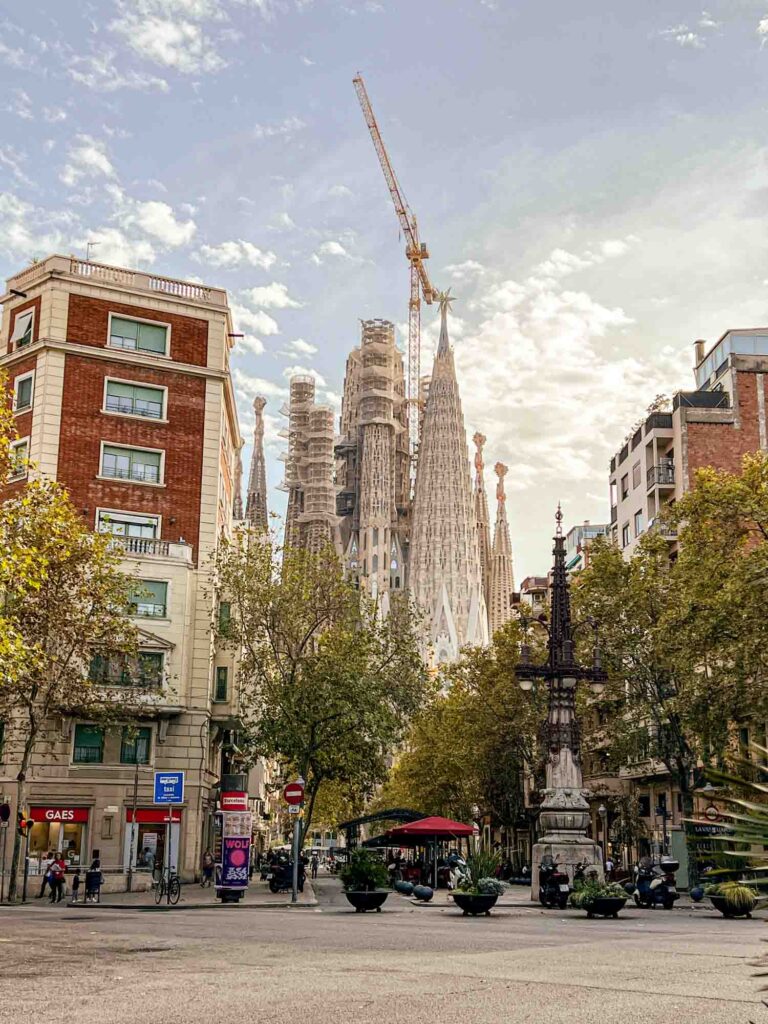
When to visit Barcelona and Andalucia
Spain experiences a Mediterranean climate, meaning that it experiences sunny days and relatively mild temperatures year-round. This means that while there’s really no terrible time to visit, some seasons are better than others.
Here is a breakdown of what to expect when visiting at different times of the year:
Summer
The summer months (June-early September) is considered to be Spain’s high season, and the most popular time to visit. Therefore, you should expect high flight + accommodation prices, as well as lots of crowds.
Spain is famous for its hot summers, especially in Andalucia, which is also Europe’s warmest region and home to the only desert on the continent. Highs can get well above 40 degrees Celsius (that’s 104 degrees Fahrenheit, y’all!), so it is pretty freaking hot. In fact, the white dwellings that the area is famous for were originally painted as a way to deal with the heat!
Still, people flock to Spain during the summer months. As such, still expect crowds and plan accordingly – book your accommodations, train tickets, attraction tickets, etc. well in advance of your trip!
If you can, though, I’d recommend completing this 10 days in Barcelona and Andalucia itinerary at a different time of year.


Spring + Fall
The spring months (March-May) and fall months (mid September-November) are considered to be Spain’s shoulder season, and the best time to visit. This is when temperatures still stay warm, but are much more bearable than the summer heat.
You’ll also find that the crowds thin out during these months. However, I still recommend buying tickets to some of the most popular attractions in advance (specifically the Alhambra, Real Alcazar, and Sagrada Familia) as those still do tend to sell out.
We visited in October, and felt that it was the perfect time to go! While we did experience some overcast skies and a little bit of rain, the temperatures were pleasant and it wasn’t super crowded.
Winter
December, January, and February are considered to be the low season in Spain. However, the weather stays relatively mild, especially in Andalucia, which enjoys highs in the mid-60s Fahrenheit.
Do note that it can get pretty cold at night, and the winter months see the highest chance of rainy days.
One advantage of visiting in the winter is that you’ll hardly see any crowds! As such, this is the time of year to find the best deals on flights and hotels.
Traveling to Spain for your 10 days in Barcelona and Southern Spain itinerary

By Air
It is very easy to fly to Spain from many cities, both in Europe and around the world, especially to Barcelona. You’ll find the most international flights (and the cheapest!), so I highly recommend that you start and end your Spain 10 day itinerary there.
If you wish, you can choose to fly to or from either Seville and Granada as well. Seville also has an airport, which mainly serves flights from other European cities. Granada also has a small airport, although it is only served by three airlines so flights there are limited. Do note that flights to either of these cities tend to be more expensive, and will require a connection.


By Train
Train travel is common in Europe, and you can travel to and within Spain via high-speed rail.
If you are traveling from France, there are a few direct trains that connect Barcelona to Paris, Nice, and Marseille. If you are traveling via train from other destinations in Europe, one or more transfers will be required.
By Car
If you’re planning to include Barcelona and Southern Spain as part of a greater European road trip, then you might arrive in Spain by car. The A-7 is the main toll road from France, and the A-2 is the major toll-free road.
Getting around during your Barcelona and Andalucia itinerary


By Train
We traveled by train on our 10 day Barcelona and Andalucia itinerary and highly recommend it. The high-speed trains in Spain are super comfortable and efficient.
While it takes about 5-6 hours to travel via Barcelona and Andalucia, I still recommend it over flying. By the time you factor in time to get to and from the airport, check in, go through security, wait for boarding, and actual flying time, it’s going to take almost as long anyway. Plus, traveling by train is just much less stressful – and you get to see the Spanish countryside.
Intercity rail service in Spain is operated by Renfe, which operates both high-speed AVE trains as well as regional lines. While the AVE trains are a bit more expensive, I highly recommend taking them to get around, as you’ll save time.
The Renfe site is notoriously difficult to figure out, especially if you don’t speak Spanish or have a foreign credit card. Instead, I highly recommend booking your train tickets on Omio. You will pay a nominal surcharge (just a few Euros), but it’s easy to navigate and book within the app and saves so much time and hassle!


Do note that the AVE trains, like many high-speed rail systems in Europe, rely on a dynamic pricing model. This means that pricing is based on demand – so, book as early as you can! When we originally started planning our trip, the fare from Barcelona to Seville was only about €60. Since we procrastinated, we ended up paying nearly €100 by the time we actually went to book. Don’t be like us!!
It also keeps all of your tickets in one place so you aren’t fumbling around your email inbox for them (I still recommend downloading the PDF copy to your phone for easy access, though).
Do note that you do have to go through a security check before you board the train, so allow extra time before departure. You don’t have to show up an hour before your train leaves like when you fly, but leave at least 30 minutes.

By Plane
The fastest way to travel between Barcelona and Andalucia is via plane. Flights between Barelona and Seville or Granada take around an hour and a half.
Flights are pretty affordable as well, particularly to Seville on Ryanair. I saw flights going for as low as $20 USD, which is considerably cheaper than taking the train! However, since we didn’t want to deal with the stress of flying (along with the pesky extra fees that Ryanair and all the other budget airlines charge), we chose the train.
Do note that Granada has a small airport, with only three airlines serving it, so flights are somewhat limited. Flights average about $60 each way, although I saw some going for around $30.


By Car
Andalucia is a popular road trip destination in Spain, so you may be considering driving for your 10 day Spain itinerary.
While Andalucia itself is ideal for a road trip, keep in mind that it is nearly 1000 kilometers from Barcelona. You will spend a considerable amount of time driving – about nine hours to be exact.
Instead of doing this entire itinerary as a road trip, I recommend that you take the train or flying between Barcelona and Andalucia. Once you arrive in the area, you can pick up your rental car (I suggest booking one on rentalcars.com) and drive around the region.
A few more tips for your Barcelona + Seville + Granada itinerary

Language
The official language of Spain is Spanish.
Out of all the cities on this Spain 10 day itinerary, you’ll find the most English being spoken in Barcelona. Most people in tourist-frequented establishments spoke at least some English (although sometimes it wasn’t great). I’d recommend having some basic Spanish knowledge, as it can come in very handy.
Do note that Barcelona is located in the Catalonia region, an autonomous region with its own language and culture. This means that in addition to Spanish, Catalan is also an official language. However, I found that virtually everyone I encountered spoke either English or Spanish, so there’s no need to learn Catalan before (but you can if you want to!).
I found myself having to rely on my (admittedly basic) Spanish when traveling through Andalucia. While you’ll hear some English spoken in Seville and Granada, it’s not nearly as much as in Barcelona. I found that there was hardly any English spoken in Cordoba – in fact, we saw several restaurant workers reply “no English” every time an English-speaking tourist said something to them.
Therefore, I highly recommend that you brush up on your Spanish skills on Duolingo before your 10 day trip to Spain! It will help you out a lot. Honestly, I found it kinda fun to be able to bust out my Spanish (however basic), and it was such a good place to practice!
Also download Google Translate for those times when you get stuck.


Currency + Money
As with many countries in Europe, Spain’s official currency is the Euro.
The exchange rate between the US dollar and the Euro tends to fluctuate a bit – luckily for us, we happened to come when the dollar was super strong! It’s rare that that happens, though.
I found that virtually all establishments accepted credit cards, but it was nice to have some cash on hand for smaller purchases. Cash is also good to have for purchases at La Boqueria.
I recommend taking out cash from an ATM over a currency exchange counter, as ATMs will always have more favorable rates. You can find ATMs all over the city, but I usually just withdraw some cash at the airport just to have it on hand and not have to think about it later (they say that the exchange rates on airport ATMs aren’t always the best though).
Tipping is not customary in Spain, although some establishments may add a service charge to your bill. For exceptional service, you can choose to leave a few Euro coins or add 10%, but it is not expected.
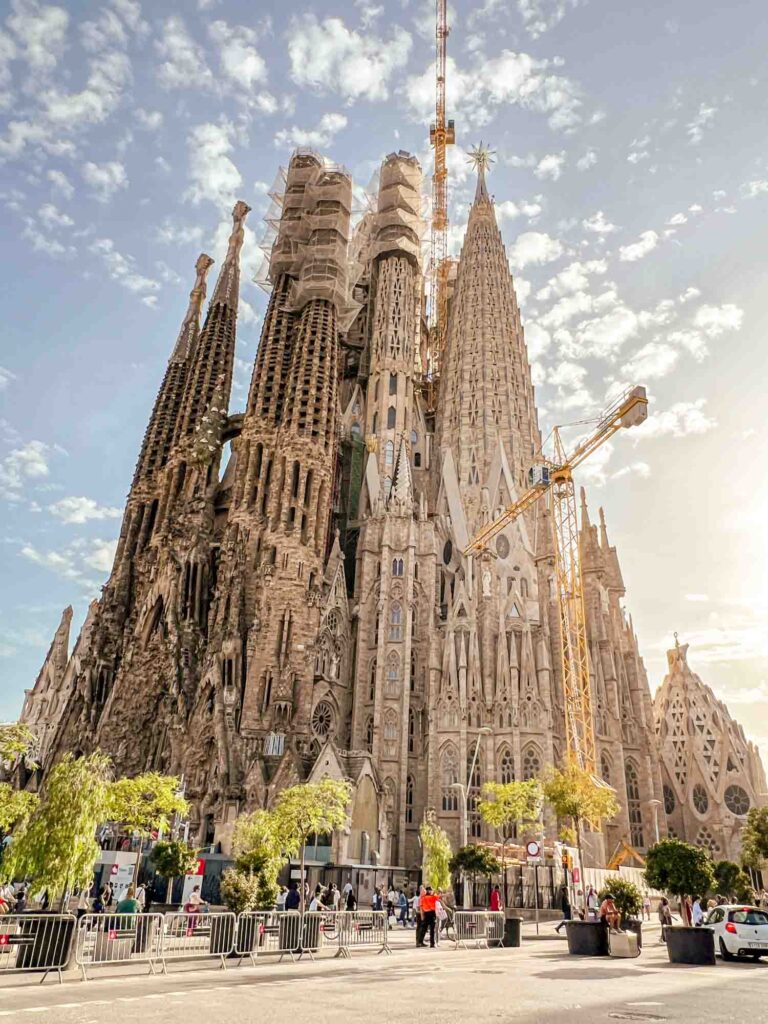
Safety in Spain
Spain is known as one of the safest countries in Europe and violent crime is extremely rare. My first time in Spain was as a solo female traveler in Barcelona, and I felt relatively safe while exploring the city on my own. In any case, you should exercise normal precautions.
However, petty crime and pickpocketing are a major concern, especially in tourist frequented areas. In particular, Las Ramblas in Barcelona is notorious for pickpockets. In any case, don’t flash valuables and keep a VERY close eye on all of your stuff! Don’t put your wallet or cell phone in your pockets, get a crossbody bag (slash proof if possible), and keep your valuables in the hotel safe.
Also be aware of tourist scams. In particular, watch out for the rosemary scam in Granada, where a woman will give you a small sprig of rosemary and offer to read your fortune. She will then demand money for her services – and sometimes an accomplice will take your stuff while you’re distracted.
While Spain is generally considered to be safe, it is important to exercise caution and use common sense. Here are a few safety guidelines to keep in mind while traveling in Spain (or really, anywhere else in the world!):
- Don’t walk around late at night, or by yourself
- If you’re out at night, walk around well-lit places where there are people
- ALWAYS be aware of your surroundings!
- Don’t carry around valuables
- Don’t go off with strangers
- Don’t get super drunk
- Always let someone at home know where you’ll be at all times and give them a copy of your itinerary

A few things to pack for your 10 days in Spain
Be sure to bring these items with you for your 10 day trip to Spain:
- Power adapter: Like the rest of Europe, Spain uses 230 V Type E plugs. If you’re coming from the United States, you’re going to need an adapter to plug in your devices. This one has several plugs, as well as USB ports.
- Comfortable shoes: You’re going to do a LOT of walking in Spain, so comfy shoes are a must! Also there’s a lot of cobblestone streets, so leave the heels at home. I love my Allbirds sneakers (like walking on clouds!) and flats (cute and comfy), as well as these Crocs sandals (which are actually really stylish, I swear!).
- Power bank: Keep your devices charged while you’re out and about – navigating and taking tons of photos can drain your phone battery super quick!
- Reusable water bottle: Like most of Europe, free tap water isn’t really a thing in Spain – and bottled water costs as much as the sangria, ha! Carry your own water with you so you can stay hydrated. I usually buy a giant bottle at a store and then fill up my bottle each day.
- Sunscreen: The sun gets pretty intense in Spain (especially in Andalucia), so don’t forget the SPF! Also, here’s my favorite face sunscreen (and a top off).


A few more tips to keep in mind…
- Siesta is kinda a thing in Andalucia: Many businesses close for a midday break, usually between 3-7pm. I also found that most attractions close by 5pm, so we struggled to find something to do between 5-7pm or so. We used it as a chance to get a little midday break of our own, and it was actually nice to have a bit of downtime!
- The Spanish eat dinner late: Most people eat dinner around 9pm. Many restaurants don’t even open for dinner until 8pm! Since we were still eating around our normal dinner time (7-8pm or so), we were able to avoid the dinner rush and were able to get into even the most popular restaurants without waiting.
- Buy attraction tickets in advance: This is especially true if you are traveling during high season, but even so for the most popular attractions at other times of the year. In particular, be sure that you buy tickets well in advance for the Alhambra (especially if you want to see the Nasrid Palaces!) in Granada, Sagrada Familia in Barcelona, and Real Alcazar in Seville.
Spain in 10 Days: The Perfect Barcelona + Seville + Granada Itinerary

Spain Itinerary Days 1-3: Barcelona
Barcelona is one of Spain’s most exciting cities, full of unique architecture, historic landmarks, laid-back beach town vibes, and incredible dining options.
Yes, it’s one of the most visited cities in Europe, and the most touristy one on this itinerary. But don’t write off Barcelona yet, as there is much to love and I guarantee that you’ll fall under its magical spell!
Barcelona makes an ideal introduction to Spain, as it is super accessible and set up for easy exploring.
Spending a few days in Barcelona will allow you to experience its highlights. You’ll get to see some of its most iconic attractions, including Gaudi’s most famous works and the historic Gothic Quarter, among other unique sights.
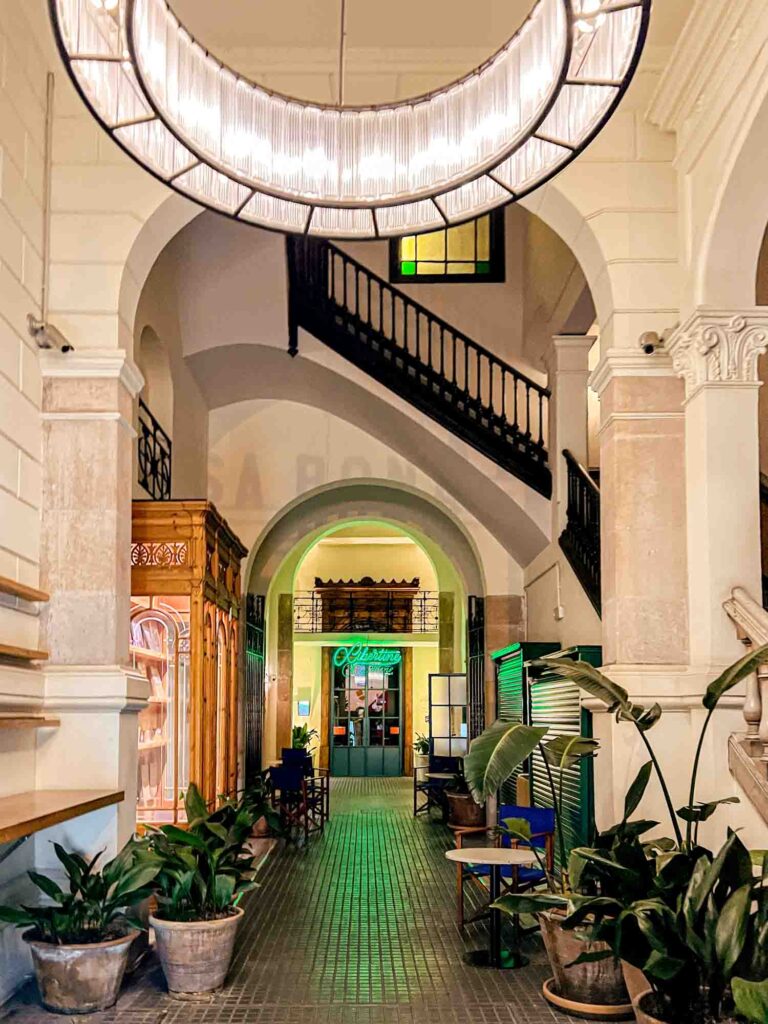
Where to stay in Barcelona
Staying in the Gothic Quarter, El Born, El Raval, or L’Eixample are your best bets. Here are some recommended places to stay in Barcelona:
- Casa Bonay: Where we stayed and loved! This hipster chic boutique hotel is located in a historical 1800s building in L’Eixample and manages to be stylish, fun, charming, and comfortable all at the same time. The rooms are on the smaller side, but there’s plenty of common spaces to hang out throughout the property, including a beautiful rooftop terrace. The staff here are super friendly and helpful as well, with plenty of recommendations for the city.
- Colon Hotel Barcelona: You can’t beat the location of Colon Hotel – it’s located right across from the Barcelona Cathedral, and conveniently located close to many of the city’s top attractions. It’s got a rooftop terrace with an insane view of the Barcelona Cathedral. Rooms are said to be spacious and comfortable as well.
- Chic & Basic Born: Chic and basic is a good way to describe this property, which has modern rooms at an affordable price point. You cannot beat the location in the heart of El Born, a short walk away from many of the city’s top sights.


Getting around in Barcelona
- Walking: The city’s charming streets make Barcelona fun to explore on foot. However, do note that the city is much larger and spread out than you’d think at first glance, so you can’t depend solely on walking to get around.
- Public transit: Barcelona has an extensive metro system that will get you to anywhere you need to go in the city. There are buses as well. A single ride costs €2.40, but I recommend getting either a Hola Barcelona transit card, which allows for unlimited rides, or a 10 ride pass for €11.35 (T-Casual card).
- Hop-on, Hop-off Bus: A hop-on, hop-off bus is a fantastic way to get around Barcelona, as it stops at all of the city’s top sights. You’ll also learn more about them and the history of the city with the included audio guide.
- Taxi: While Uber is technically available in Barcelona, there aren’t very many cars and taxis are much more convenient. I recommend downloading the Cabify or FreeNow, as it works similarly to Uber but is for taxis.


How to save money in Barcelona
Barcelona is one of the most expensive cities in Spain (it was definitely the most expensive that we visited on this Spain in 10 days itinerary), and costs for attraction tickets add up *very* quickly.
If you’re looking for ways to save money in Barcelona, I recommend that you purchase the GoCity Barcelona Pass. This all-inclusive pass includes admission to many top Barcelona attractions and experiences. Some of the included sights on this itinerary are Casa Batllo, Casa Mila, Sagrada Familia, and Park Guell.

Day 1: Arrive in Barcelona
Welcome to Spain! The first day of this 10 days in Barcelona and Southern Spain will be relatively chill, as you are probably still recovering from traveling. How much time you have for exploring will depend on what time your flights/train get in. For us, we got in in the afternoon, so we had a half day to explore the city.
Arriving in Barcelona
- Arriving via air: Barcelona’s Josep Tarradellas Barcelona-El Prat Airport is located 14 kilometers outside of the city center. The easiest way to get into the city center is via the Aerobus, which offers frequent service to Placa de Catalunya. The trip takes roughly 35 minutes and the fare is €8.90 one way, or €13.20 return. You can also take a taxi – this costs €30-35 and takes around 25-30 minutes.
- Arriving via train: Barcelona’s main railway hub is the Sants station, located about 3 kilometers from Placa Catalunya. Multiple metro lines also run through Sants, so it is an easy connection to the rest of the city. You can also hop in a taxi from here to get you wherever you need to go.
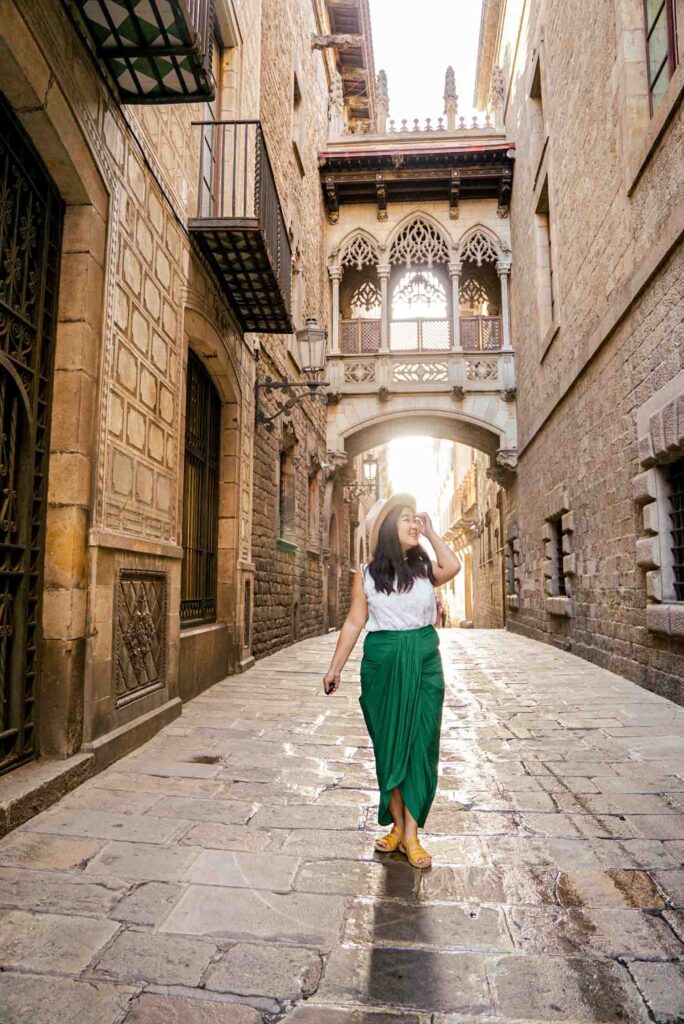
Explore El Born and the Gothic Quarter
After checking into your accommodations, it’s time to start exploring Barcelona!
The Gothic Quarter is the oldest part of Barcelona, dating back to Roman times. You’ll find a labyrinth of windy streets, cobblestone streets, and unique historical attractions, including the Barcelona Cathedral.


El Born is also one of Barcelona’s oldest neighborhoods, characterized by its narrow medieval streets. Today, it is one of the hippest areas in the city, with plenty of trendy bars, restaurants, cafes, and boutiques. I loved walking through the picturesque streets here, it’s one of my favorite neighborhoods in Barcelona!
While you can certainly wander these neighborhoods on your own, I also recommend taking a walking tour to get acquainted with the area and learn more about its unique history. I always enjoy this as a way to get my bearings in a city. If you’re a bit hungry, you can even take a tour that includes tapas (and even wine!).

Barceloneta
You may not immediately associate Barcelona as being a beach town, yet that is exactly what it is. Barceloneta is home to the city’s most popular beach, one of the sites that was revitalized for the 1992 Olympics.
Walk along the waterfront and take in the palm trees and skyline views. You’ll also see the W Hotel, one of the most famous hotels in the city. Then, stop at one of the beachside bars for sunset..
For dinner, there are many amazing restaurants that you can choose from in Barceloneta. Two of my favorites here are Jai–Ca, a super traditional tapas bar with some delicious seafood; and Bitacora, a modern tapas spot with a hidden terrace and fantastic patatas bravas and bombas (a Catalonian version of croquetas).
Day 2: Barcelona
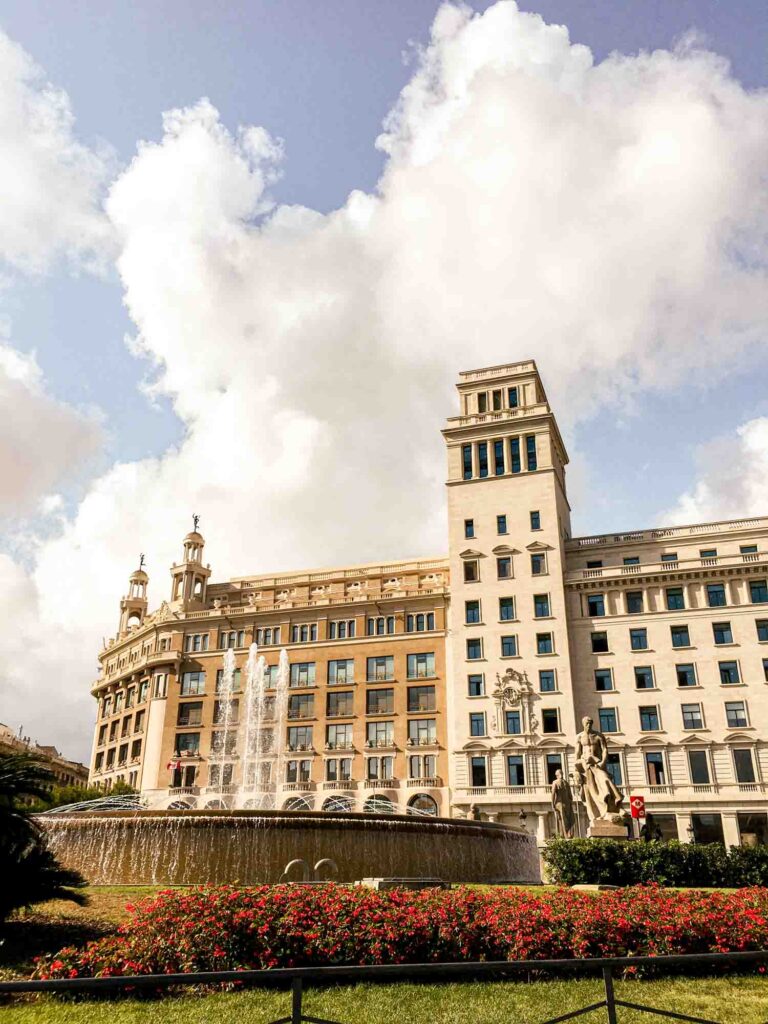
Placa de Catalunya
Placa de Catalunya is one of the most important squares in Barcelona, known as the heart of the city. You’ll also find some notable sculptures, fountains, and monuments contained within the square, many of which were built by famous Catalan artists.
The square is steeped in history and has been a central gathering place in the city since 1927. It is a popular meeting spot in the city, and is surrounded by many shops, restaurants, hotels, bars, and theaters.
Las Ramblas
Las Ramblas is *THE* most famous street in the city, a tree-lined, pedestrian-only boulevard that stretches 1.2 kilometers from Placa Catalunya to the Christopher Columbus Monument at Port Vell.
It is *VERY* touristy here (kinda like Fisherman’s Wharf in San Francisco or Navy Pier in Chicago), so I wouldn’t spend too much time here. Still, it’s one of the most iconic places in the city, so you gotta see and experience it on your Spain 10 day itinerary.
An important word of caution: Keep a very, VERY close watch on your belongings here – Las Ramblas is notorious for pickpockets!


La Boqueria
I always love visiting markets when I travel, as they always provide such a fascinating look into local life and food culture (some of my favorites are Pike Place in Seattle, the Jean-Talon Market in Montreal, and the Mercado Central in Antigua, Guatemala).
La Boqueria is one of the most famous markets in the world, and dates back to the 13th century. Over 300 vendors are located here, and it is an absolute feast for the senses! You’ll find plenty to snack on here – the candy vendors and the fresh fruit juices here are the BEST!
While you’re here, try to snag a counter spot at El Quim de la Boqueria and order the squid and eggs (and order extra bread to soak up the juices!).
For a unique experience, I suggest taking a market tour, where you walk through the market with a trained chef, and make your very own paella using all the ingredients you picked up there.
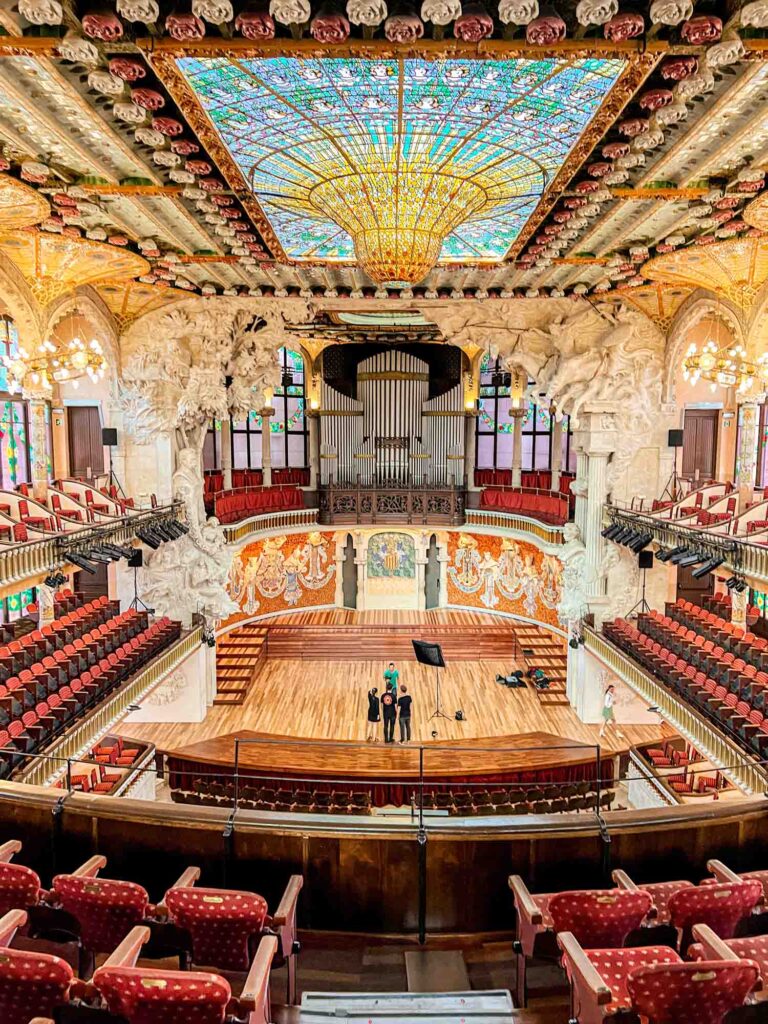

Palau de la Musica Catalana
Barcelona is a city full of architectural marvels, and the Palau de la Musica Catalana is one of its most stunning. You can choose from a self-guided visit or guided tour. I was completely in awe as I walked through the venue – from the colors, ornate details, to the stained glass.
The Palau is known as one of the most beautiful concert halls in the world, and is the only one listed as a UNESCO World Heritage site. Designed by Lluis Domenich i Montaner, a contemporary of Gaudi, it is a shining example of Catalan Art Nouveau architecture.
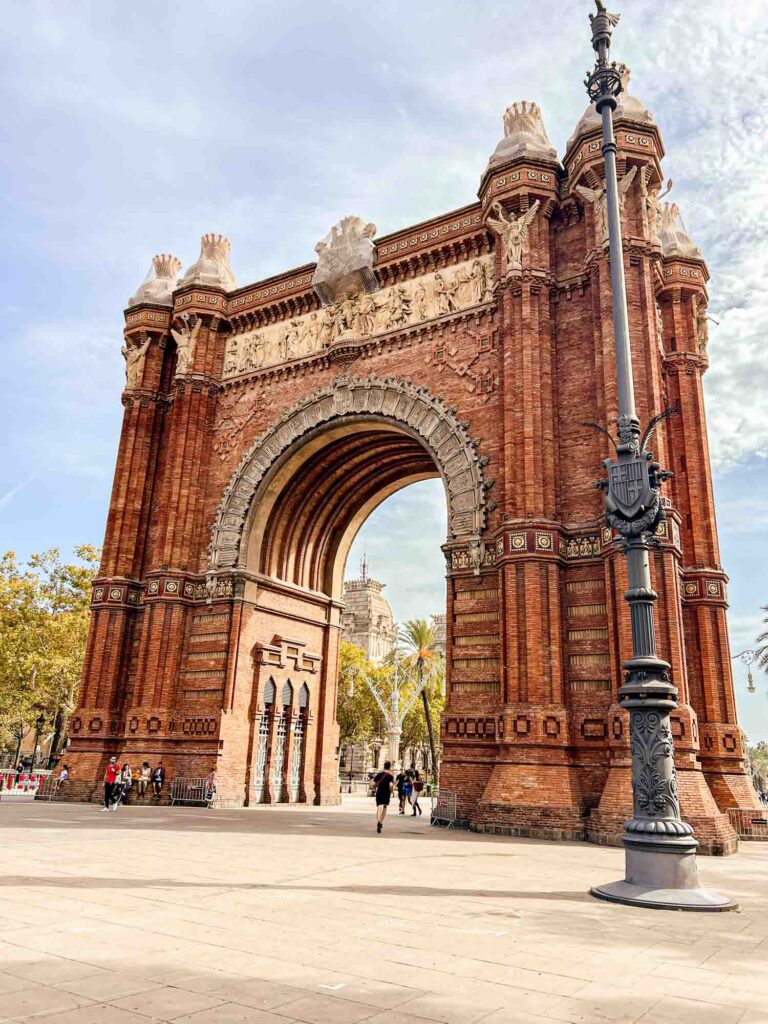
Arc de Triomf
The Arc de Triomf is one of Barcelona’s most recognizable landmarks. You cannot miss the towering arch as you walk down Passeig de Sant Joan. Built in 1888 when Barcelona hosted the World’s Fair, the arch symbolizes the gateway for modern Barcelona.
It draws comparison to the famous Arc de Triomphe in Paris, but it isn’t exactly a copy. The two arches boast distinctly different architectural styles and purposes – the French version is built in the Neoclassical style commemorating soldiers, while the Barcelona version is made of brick and dedicated to agriculture and industry.
Parc de la Ciutadella
The Arc de Triomf also serves as the entrance into Parc de la Ciutadella, one of the most beautiful green spaces in the city. The park is home toa boating lake, a collection of statues, and a tropical greenhouse, as well as the Barcelona Zoo and the Catalan Parliament buildings.
Perhaps the most notable monument here is the ornamental fountain, designed by architect Josep Fontsere, with the help of a young Antoni Gaudi.


Dinner at Bar del Pla
I loved Bar del Pla so much that I ended up coming twice!
You’ll find a menu of modern tapas with unique flavor combinations. It’s different from your traditional tapas that you can find anywhere, and the dishes have a playful spin. And obviously – everything is DELICIOUS!
Day 3: Barcelona


Casa Batllo
Casa Batllo is one of Gaudi’s signature works and an absolute must-see on your Barcelona + Seville + Granada itinerary. Commissioned by a wealthy family, Gaudi used some of his most unique ideas to transform the residence, taking inspiration from nature and eschewing straight lines.
I suggest coming first thing in the morning, as Casa Batllo tends to get super crowded as the day goes on. You can also book a Be the First ticket, which allows you to enter an hour before everyone else.


Casa Mila
Casa Mila is located down the street from Casa Batllo, and I recommend visiting both as kind of a contrast. The house may seem kind of plain from the outside, but I swear it is well worth visiting!
This is regarded as one of Gaudi’s most creative works, and is especially renowned for its functional and constructional innovations. Absolutely do not miss the rooftop here, which features some distinctive chimneys, made to look like soldiers guarding the house.
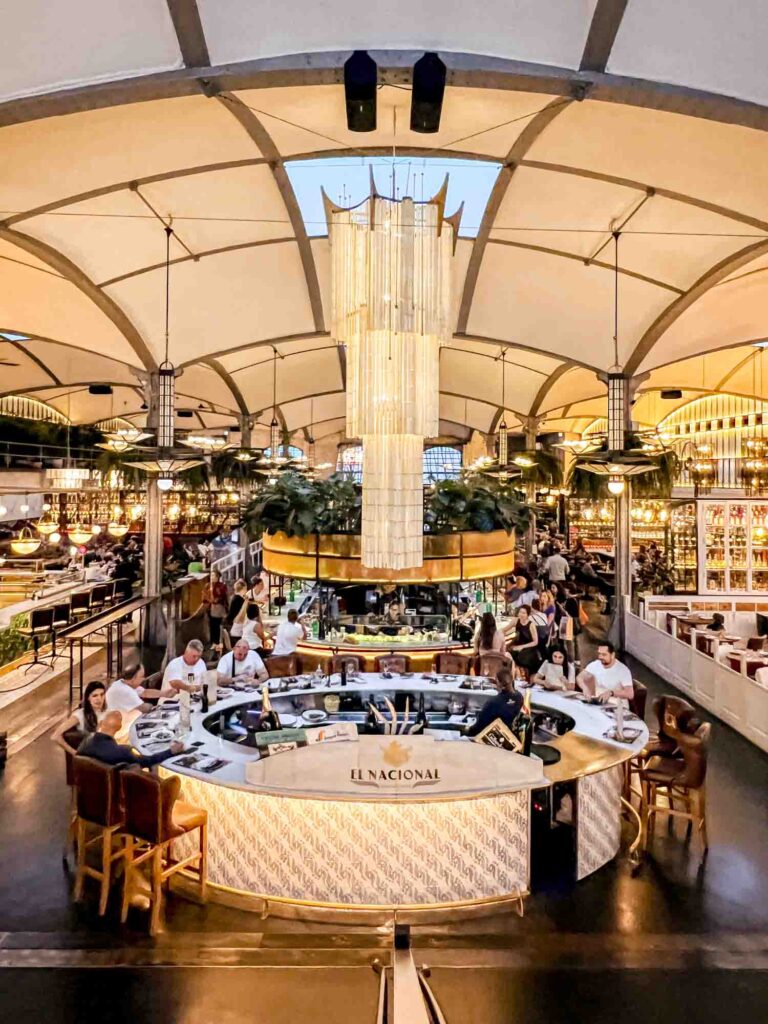
El Nacional
Your next stop is El Nacional for lunch! If you’re familiar with the concept of Eataly – well, this is kinda like the Spanish version of it. You’ll find a number of restaurants and eateries featuring different concepts in traditional Spanish cuisine.
Not to mention – the space is so absolutely beautiful that it’s absolutely worth a stop even if you’re not hungry!

Sagrada Familia
You cannot spend 10 days in Spain and *not* visit the Sagrada Familia – no ifs, ands, or buts!
Sure, there are a lot of churches in Europe, but this is like no other. I’ve never seen anything like it! You can truly see Gaudi’s genius come to life in the Sagrada Familia. I was absolutely blown away by the Sagrada Familia, from the whimsical details and the colorful stained glass.



Not only is the Sagrada Familia perhaps Gaudi’s most well-known creation, it’s also one of the most visited sites in Spain so plan accordingly. I *highly* recommend buying your tickets in advance, as they tend to sell out even when it’s not peak season.
Also do not miss the museum in the basement (near the souvenir shop), as it has tons of interesting exhibits about Gaudi and the construction of the church. And, if you want to photograph the exterior of Sagrada Familia in all its glory, head to the park across the street.


Recinte Modernista de Sant Pau (optional)
If you have extra time on your itinerary, I recommend making a stop at the Recinte Modernista de Sant Pau. Initially designed as a garden city, the complex was used as a hospital for nearly a century.
The complex was designed by Lluis Domenich i Montaner, the architect behind the Palau de la Musica Catalana. Similarly, it is another shining example of Catalan Art Nouveau architecture, with vibrant colors and spectacular architectural details – it is pure eye candy!

Park Guell
The last stop on the Barcelona part of your 10 day Spain itinerary – Park Guell! This is Gaudi’s whimsical wonderland, and was originally intended to be a private community for the wealthy. However, the project failed and it was turned into a public park – lucky us!
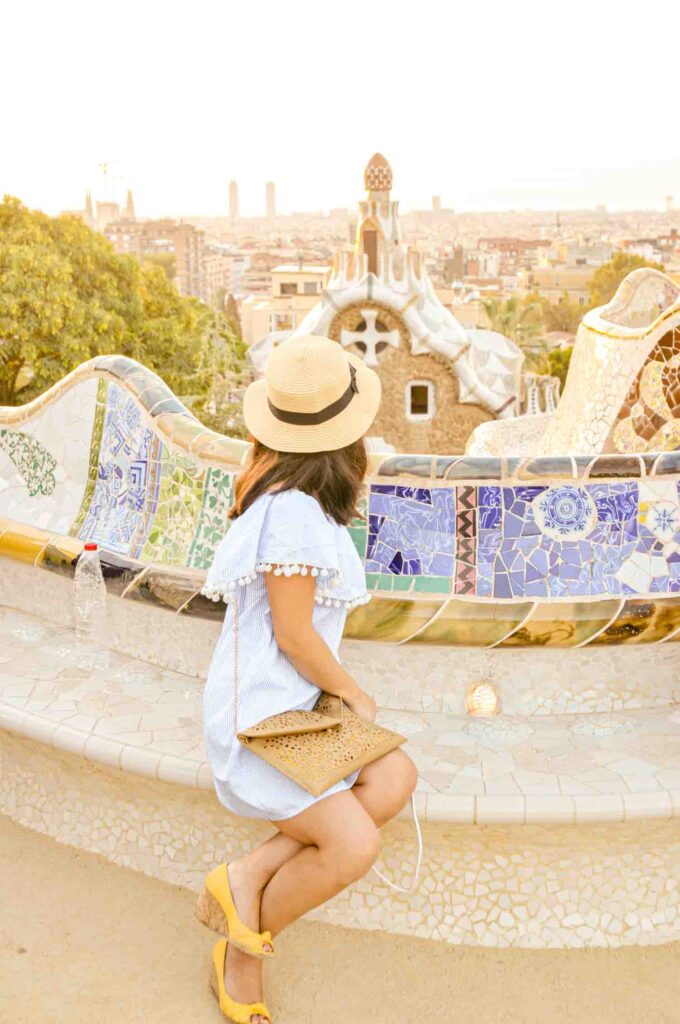


While Park Guell is technically free to visit, you need a ticket to visit the Monumental Zone, which is where all the most notable works are located. Some highlights include the entrance plaza and the salamander fountain, the Hypostyle Hall, the gingerbread houses, and the corrugated mosaic bench that looks over the park and city (perfect for sunset!).
If you’re looking to eat some dinner after this, I recommend heading to La Paradeta, which has several locations throughout the city, including one near Park Guell. Essentially, you pick what seafood you want, they cook it, and you eat it – sooo good!
Be sure to also read my complete Barcelona itinerary for tons more helpful info on planning your stay here!
Barcelona and Southern Spain Itinerary Days 4-6: Seville

After spending a few days in Barcelona, it’s time to head to the next stop on your 10 days in Spain itinerary – Seville!
The capital of Andaluica, Seville is one of the most enchanting cities in Spain, often associated with orange trees, Moorish architecture, and flamenco. I absolutely fell in love with Seville (it just might have been my favorite stop!) and its picturesque streets, unique architecture, and ubiquitous charm.
I promise that after spending a few days in Seville, you’ll fall in love too!
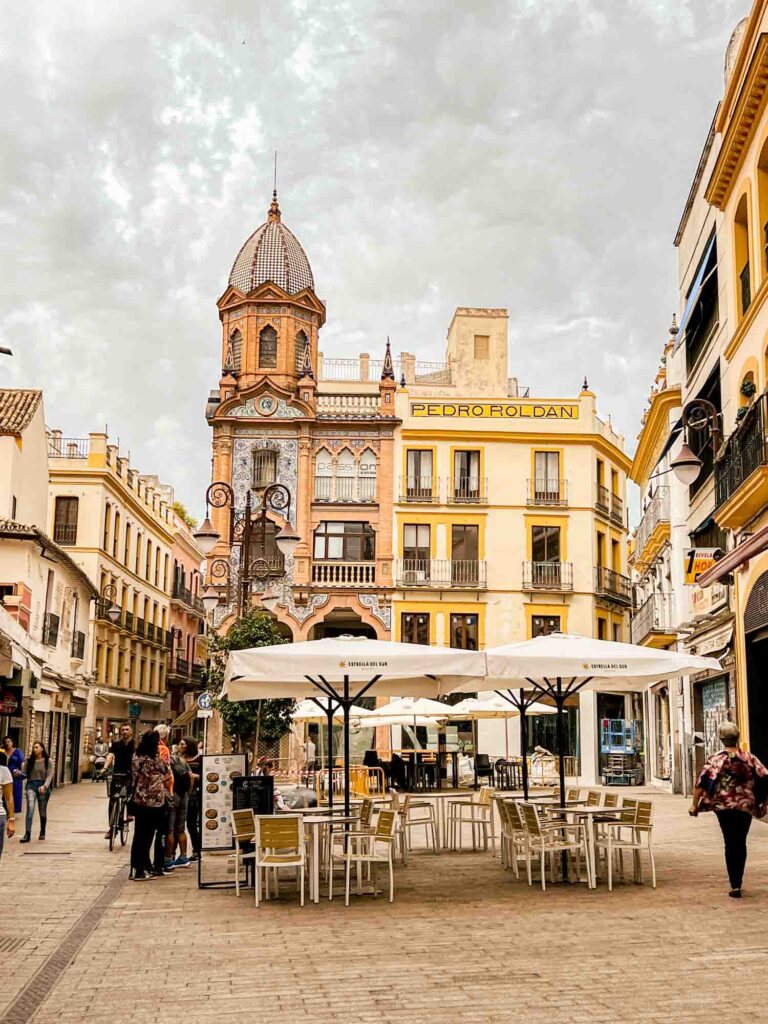
Where to stay in Seville
Seville is pretty compact, so you can stay pretty much anywhere within the historic center and get around easily to wherever you want to go. Here are some suggestions for where to stay in Seville:
- Hotel Giralda Center: This is where we stayed . It had just opened when we visited, so we weren’t what to expect, but really enjoyed staying there! The property has an elegant, modern, boutique feel, and everything looked new and super clean. The location was convenient – we could walk everywhere within 30 minutes or so. There’s also a rooftop pool, although we never made it up there.
- Hotel Alfonso XIII: If you’re looking to splurge a bit, you can’t do much better than the Hotel Alfonso XIII. This luxury hotel was commissioned by King Alfonso XIII and just screams royalty! You’re conveniently located right across from the Real Alcazar, and the service is said to be impeccable.
- Hotel Casa del Poeta: This hotel is housed in a restored 17th century mansion, and it still retains its grandeur, with traditional decorative details. It looks absolutely stunning inside, and you can’t beat the location in the heart of Barrio Santa Cruz, just a few minutes’ walk from the Cathedral.


Getting around in Seville
- Walking: Seville is super easy to explore on foot. Many of the top sights in Seville are located within the historic center, which is pretty compact – you can get from one end to the other in about 30 minutes.
- Public transportation: There is a tram that makes four stops along a 1.4 kilometer route in the center of Seville. The city also has an extensive network of buses. Seville does have a metro line, but it’s mostly used for residents to commute to and from the suburbs.
- Taxi: There is no rideshare service in Seville, but there are taxis that run throughout the city. You can catch one at one of the taxi stands throughout the city, but you can hail one as well. We ended up taking a taxi when we got caught in pouring rain while in Triana and found it pretty easy.
Day 4: Barcelona to Seville


Arriving in Seville
- Via Train: There are two direct trains daily from Barcelona to Seville – one departing in the morning, and another in the afternoon. Hop on the morning train which leaves at 8:35am, which will have you in Seville at 2:10pm. You will arrive at Sevilla Santa Justa station, located about 4 kilometers from the city center. From here, take a taxi (it costs us less than 10 euros) or bus (lines 28, 32, C1, or C2) your accommodations.
- Via Air: Seville’s airport is located 9 kilometers east of the city center. From here, you can take the EA bus to Plaza de Armas in about 30 minutes. You can also take a taxi, which takes about 15 minutes and costs around €30.

Wander around Barrio Santa Cruz
After checking into your hotel, it’s time to start exploring Seville! I suggest starting in the Barrio Santa Cruz neighborhood, which is filled with colorful streets, quaint squares, and historic palaces. It’s also home to some of Seville’s top sights, but we’ll come back to those later. For now, just walk the streets and take in the charm of Seville.
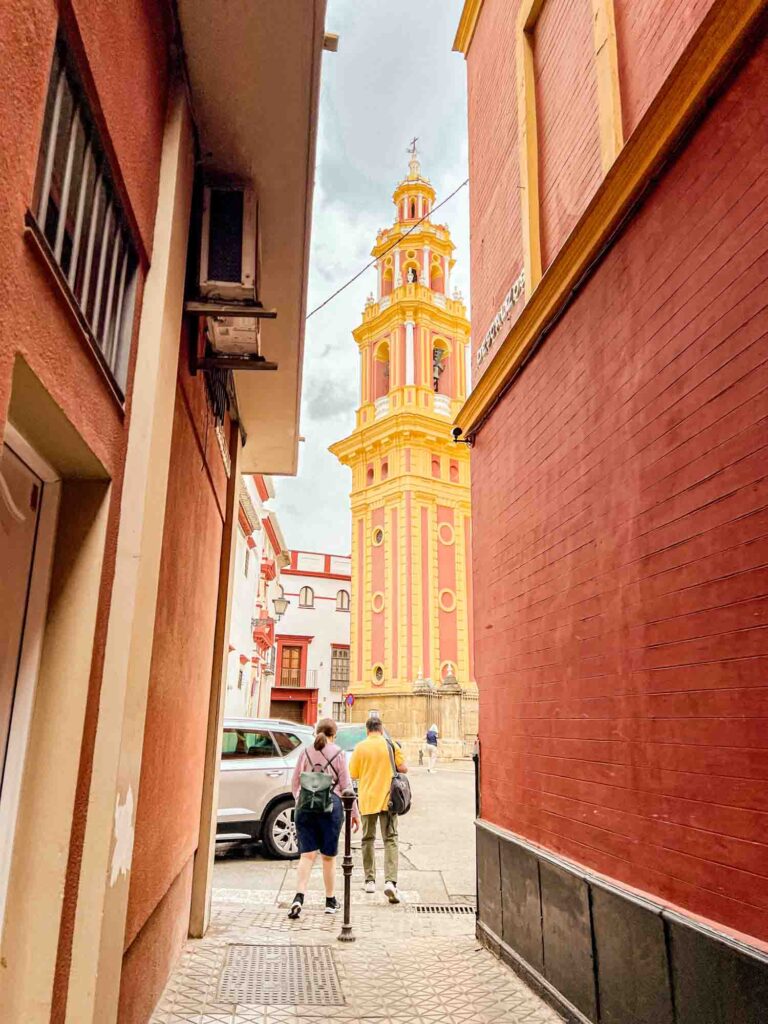


Barrio Santa Cruz dates back to the 13th century, when it was the Jewish Quarter of the city. Unfortunately, the Jews were eventually ousted when the Christian monarchs took over and forced everyone to convert to Christianity.
I highly recommend taking a walking tour, which will allow you to learn a lot more about the history of the neighborhood, as well as Seville.
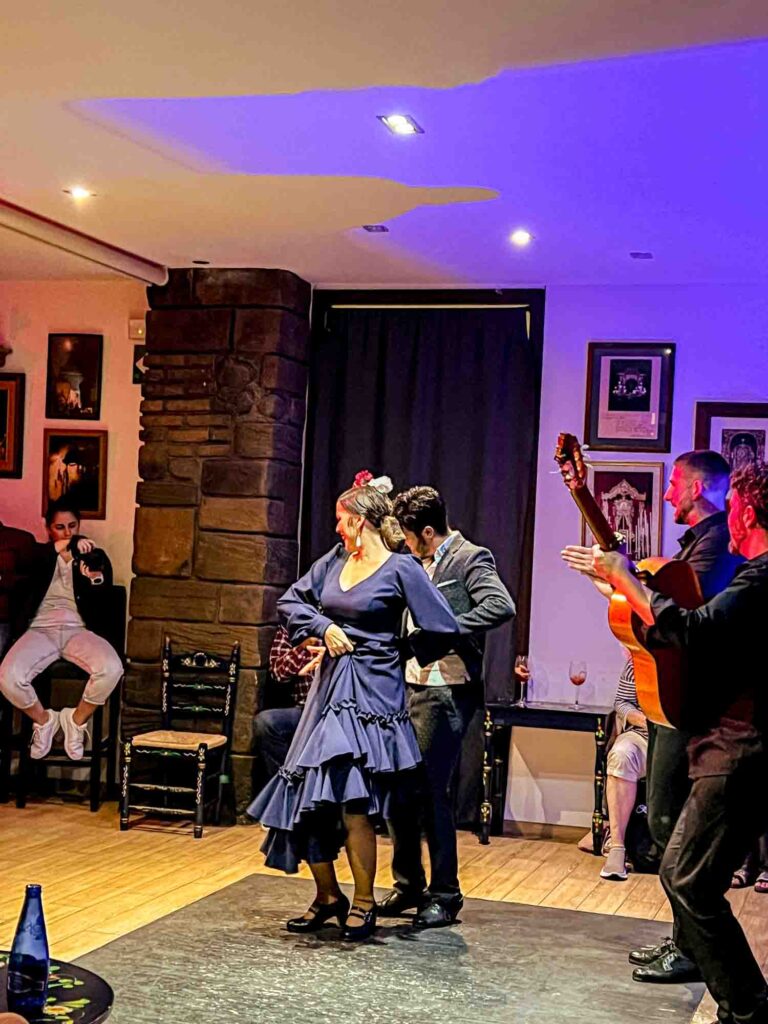
Attend a flamenco show
Flamenco is one of Spain’s most beloved cultural traditions, and Seville is its birthplace. Therefore, you should definitely see a flamenco show while in Seville!
Flamenco is said to have originated in Triana, which was once the city’s gypsy quarter. There are tons of options for flamenco shows in town, but why not see a performance where it all started?
We booked this flamenco show, which takes place in an intimate venue and comes with a drink. I was totally transfixed and could not take my eyes off the dancers. I was also blown away by the emotion in the performance, both in the dancing and music!
For dinner, I recommend stopping at Blanca Paloma, a traditional tapas bar in Triana. Depending on what time your show is at, you can eat before or after the performance.
Day 5: Seville

Plaza de Espana
Seeing photos of Plaza de Espana on Instagram is initially what put Seville on my bucket list – seeing it in person was surreal. I couldn’t get over how beautiful it was, and it was definitely a highlight on my Barcelona + Seville + Granada itinerary. Every single detail of the square is so ornate and mind-blowing that I could not get enough!



Located in Maria Luisa Park, many of the buildings in Plaza de Espana were built for the 1929 Ibero-American exhibition, and today hold government offices. The sprawling square features a mix of neo-Renaissance and neo-Moorish architecture, with 50 azujelo frescoes representing each province of Spain and four bridges to symbolize the medieval kingdoms of the Iberian Peninsula.
Plaza de Espana gets busy as the day goes on, so I suggest coming first thing in the morning. We arrived around sunrise (which is around 8:30 in October) and virtually had the place all to ourselves. It was incredible to be able to take in the beauty and all of the details of the square in peace and quiet!


Casa de los Pilatos
One of the gems of Seville, Casa de los Pilatos is a 16th century palace nestled within Barrio Santa Cruz. Here, you will see a stunning blend of Renaissance, Mudejar, and Gothic architectural styles, as well as a spectacular display of azujelos tiles.
There’s both a summer palace (ground floor), and a winter palace (upper floor) here, but you need to book a guided tour to visit the upper floor, which is still occupied by the Dukes of Medinaceli. There’s also a garden featuring an array of Greek and Roman sculptures.

Palacio de las Duenas
Palacio de las Duenas is a 15th century palace that was once home to the late Duchess de Alba, one of Spain’s most prominent aristocrats. It’s Renaissance in design, but like most other buildings in the area, features a mix of architectural styles.
The inside of the estate displays an extensive collection of tapestries, paintings, and memorabilia, but the highlight here is the stunning courtyard and gardens.

Metropol Parasol (Las Setas de Sevilla)
Metropol Parasol is one of the most unique architectural structures in Seville, a modern landmark that stands out in a sea of historical monuments.
Often referred to as “the mushrooms” (or Las Setas) due to its unique mushroom-like shape, it is the largest wooden structure in the world and was originally designed as part of a project to revitalize the area.
You can take an elevator to the top of the structure, from where you can get a fantastic view of the city, especially at sunset. We didn’t go up because it was overcast and gloomy during our entire stay in Seville, but still thought it was so cool from below!
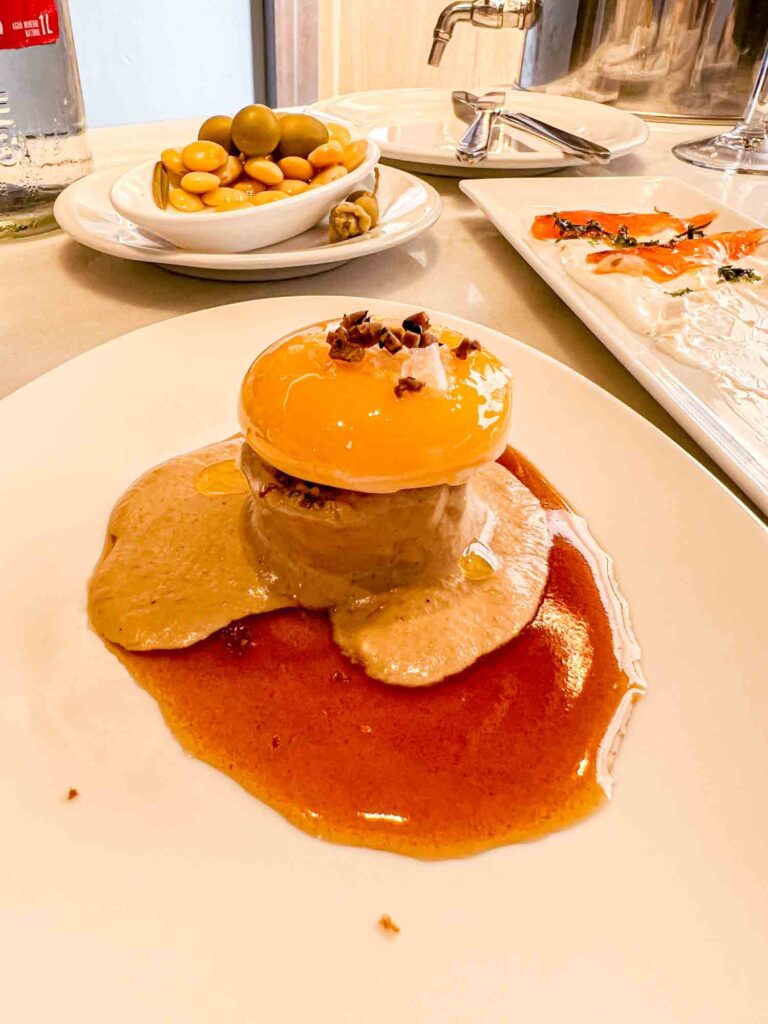

Dinner at Espacio Eslava
Whatever you do, do NOT leave Seville without eating at Espacio Eslava. This was probably our favorite restaurant during our 10 days in Spain, and we loved it so much that we ended up coming back a second time!
Espacio Eslava features an extensive array of creative modern tapas. You can’t go wrong with anything you order here, but definitely get the egg yolk on boletus cake, and the squid ink “cigar.” The presentation is insane (everything looks super fancy!), but all the tapas are super affordable.
Day 6: Seville
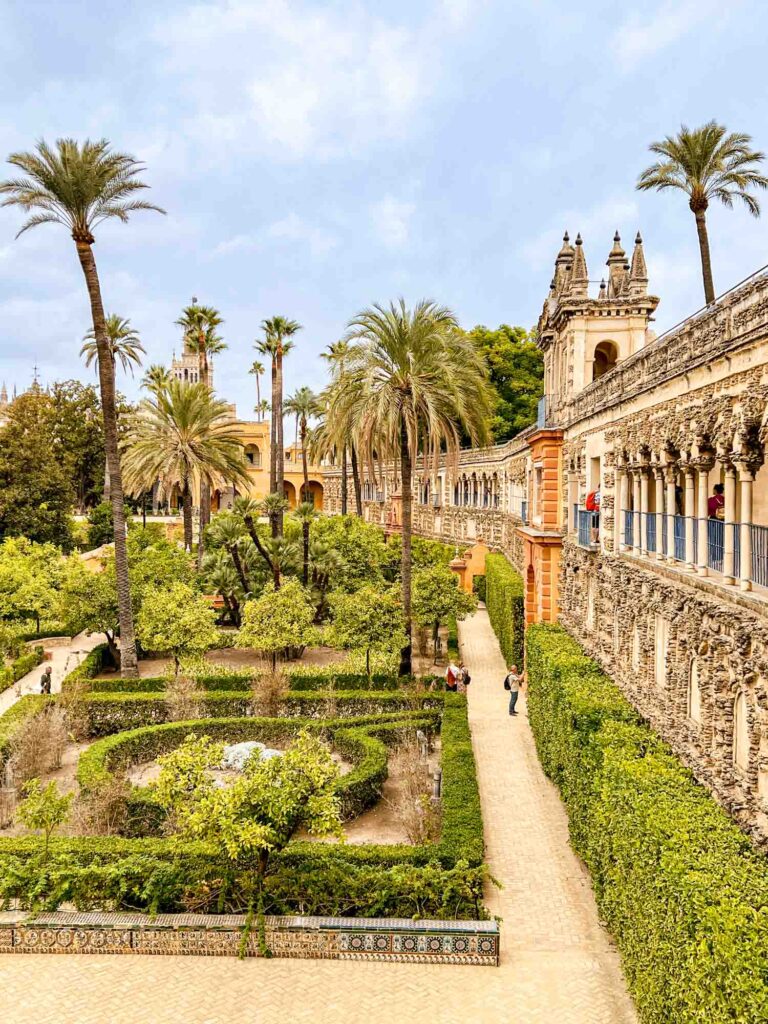
Royal Alcazar of Seville
I guarantee that the Royal Alcazar will be one of your highlights during your 10 day Spain itinerary. Not only is it absolutely stunning, there’s a ton of fascinating history behind it!
First things first, though – book your tickets in advance! This is one of the most popular attractions in Spain, and tickets do tend to sell out. Also absolutely book the first time slot of the day (9:30am) for the least amount of crowds.
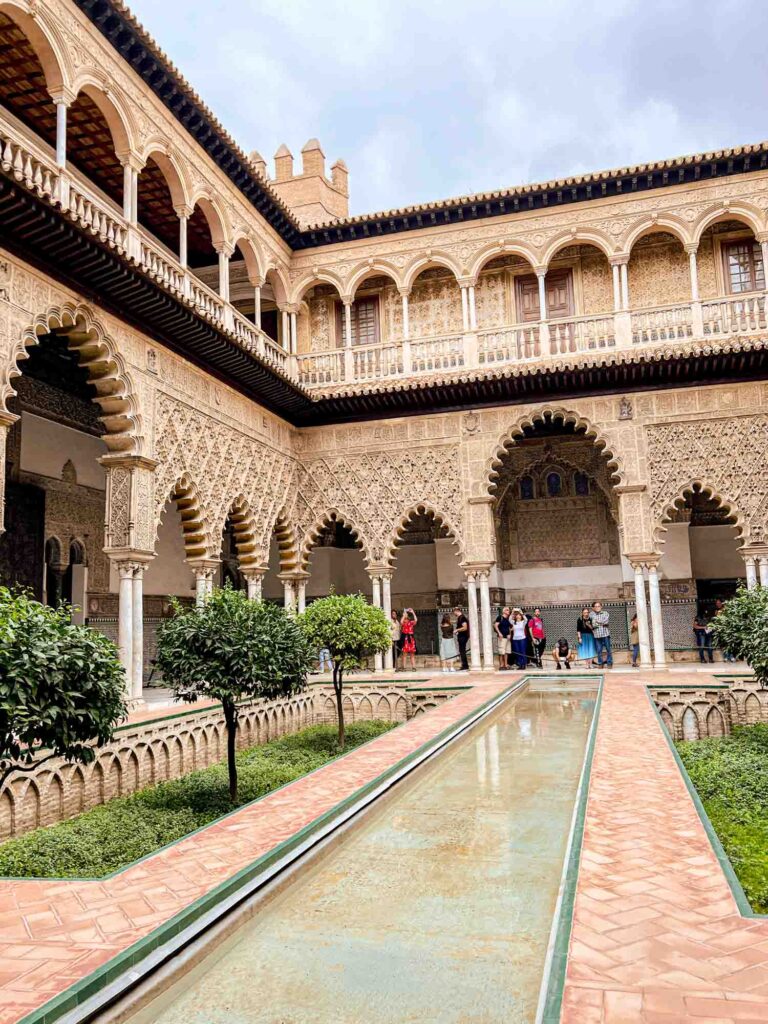


Whenever you visit though, every inch of the Royal Alcazar is absolutely spectacular, from the unique fusion of architectural styles, the courtyards, and the lush gardens. If any of the grounds feels familiar…that’s because, OH BY THE WAY, the Royal Alcazar was used as Dorne in Game of Thrones!
We did a self-guided visit, but I kinda wish we did a guided tour, as I would’ve loved more historical context about the Real Alcazar (especially after doing a guided visit of the Alhambra).
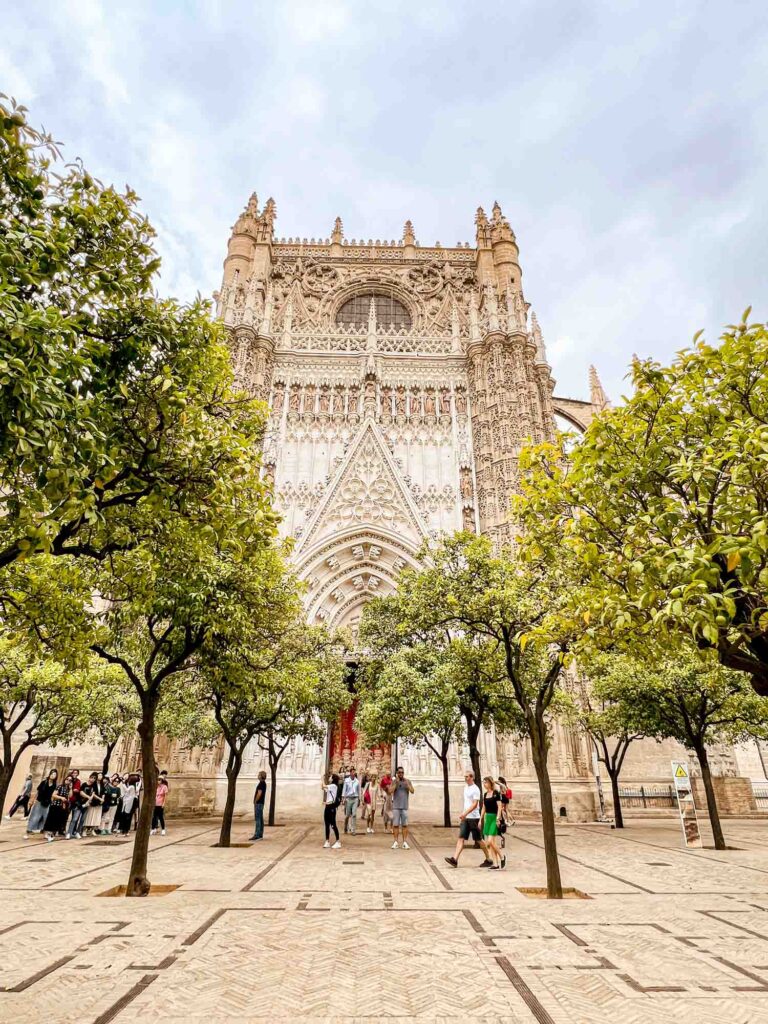
Seville Cathedral + La Giralda
You can’t help but gawk at the Seville Cathedral. The largest church in Spain (and third largest in Europe) also is the largest Gothic building in the world. It has a striking exterior that immediately captures your attention with ornate details on its facade.



The inside of the cathedral boasts 12 chapels, and is also known as the final resting place for Christopher Columbus.
Your entry ticket also includes admission up to the Giralda tower, which is also a must! You’ll head up 35 ramps to get to the top of the 104 meter tower, but the views from the top are worth it (don’t worry, it isn’t as bad as climbing to the top of the Duomo in Florence).


Triana
After visiting the Seville Cathedral, head across the river to explore Triana. This lively neighborhood is best known for producing some famous bullfighters and flamenco dancers.
I loved that Triana has a much more local vibe – we didn’t see very many tourists here. There aren’t really any notable attractions (aside from the Mercado de Triana market), but it was cool to walk through its streets and experience an authentic slice of Sevillan life.
It’s also an artistic neighborhood, known for its tiles that were once made using the mud from the Guadalquivir River here until it was silted down.

Torre del Oro
After visiting Triana, head back to the historic center and walk down the waterfront. I loved the views across the river, dotted with the colorful buildings of Triana. I imagine it would’ve been even more beautiful on a sunny day, but sadly it was pretty overcast the entire time we were in Seville.
Along the waterfront, you’ll come across Torre de Oro, a 13th century defensive tower built to protect Seville from possible attacks from the river. It was also used as a prison during the middle ages. Today, there’s a naval museum at the base of the tower, as well as a viewing deck on the rooftop.


Dinner at El Rinconcillo
One last meal in Seville – this time at the city’s oldest tapas restaurant!
El Rinconcillo has been around since 1670, and serves up an array of delicious traditional tapas. It gets super packed here, so go right at opening! They open at 8pm, we got there at 8:05 and they squeezed us in at the counter. By the time we left, there was a long line of people waiting outside.
This is an awesome place to try Espinacas con Garbanzos and Salmorejo, two tapas that are traditional to Andalucia.
Be sure to also read my complete Seville itinerary for more detailed info on what to do, where to eat, + more helpful tips!
Spain Itinerary Day 7: Cordoba
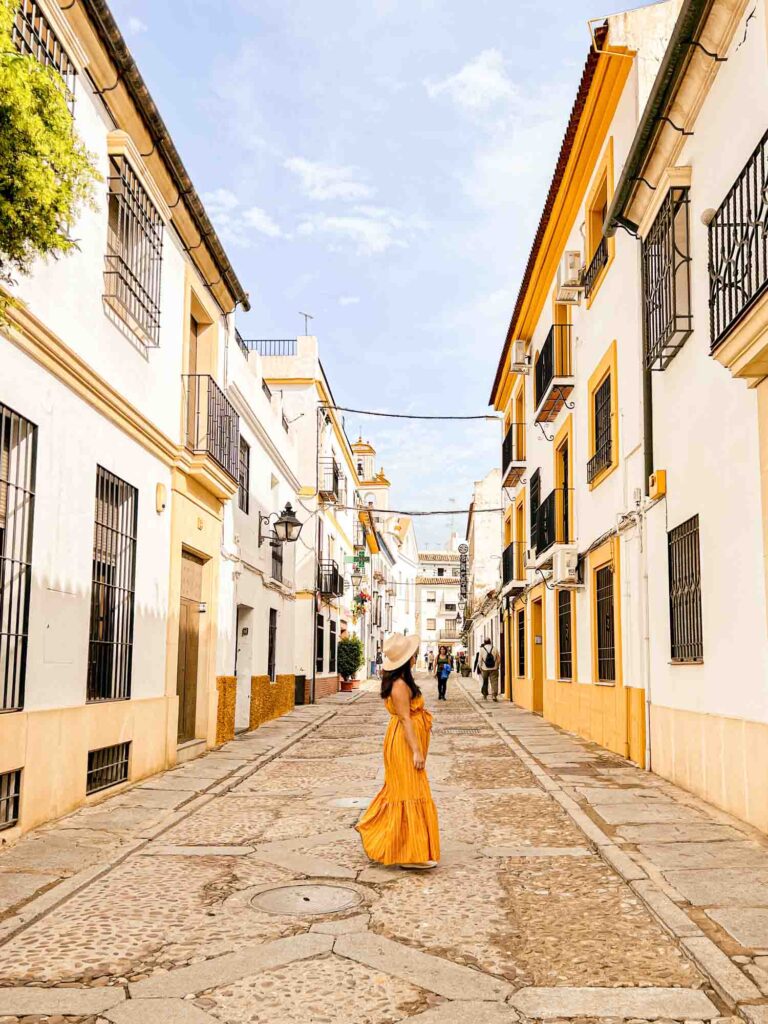

Day 7 on your Barcelona + southern Spain itinerary features a day trip to Cordoba, one of the most fascinating cities in Andalucia. It is an easy trip from Seville to Cordoba, and well worth the quick stop on the way to Granada.
Nowhere is the confluence of Moorish, Islamic, and Christian cultures most apparent than in Cordoba, where Jews, Muslims, and Christians coexisted for many years. This all changed after the Reconquista, of course, but it was fascinating to see the remnants of those times.
Cordoba may be small, but it packs a lot of beauty, charm, and history. In fact, it is home to the most UNESCO World Heritage Sites than any other city (4). However, its compact size means that you can easily explore it in a day.
Day 7: Seville > Cordoba > Granada

Traveling to Cordoba from Seville
The easiest and best way to get from Seville to Cordoba is by train. Service is frequent, with about 25 departures a day. You can take a high-speed AVE train, which will have you there in around 45 minutes (which is faster than driving!). If you’re on a budget, you can take a slower regional train as well, which takes about an hour and 20 minutes. Book your ticket on Omio for the most convenience.
Plan on arriving in Cordoba by 9:30am – this will give you a chance to arrive, store your stuff, and head straight to the Mezquita right when they open. We took a train that arrived around 8am so we were able to stop for breakfast and coffee first.
Other ways to get to Cordoba include taking an Alsa bus (~2 hours) from Plaza de Armas in Seville, or driving (1 hour, 40 minutes).
If you’re looking for a place to store your luggage while you are exploring Cordoba: There are lockers available at the bus station across the street from the train station. Get there early as space is limited.

Mezquita-Catedral de Cordoba
Chances are that if you’ve heard of Cordoba, it’s because you’ve seen a photo of the Mezquita, the Mosque-Cathedral of Cordoba.


The Mezquita dates back to the 8th century and is one of the best preserved Islamic buildings in the world. Originally built by the Visigoths, then used as a mosque, and then turned into a cathedral under Christian rule, it’s a fascinating monument that symbolizes the confluence of cultures in Cordoba.
As you walk in, you’ll find a forest of nearly 1000 candy cane arches, built with granite, marble, onyx and jasper. It’s truly an astounding sight that will take your breath away – it was certainly one of the highlights on my 10 days in Spain itinerary!
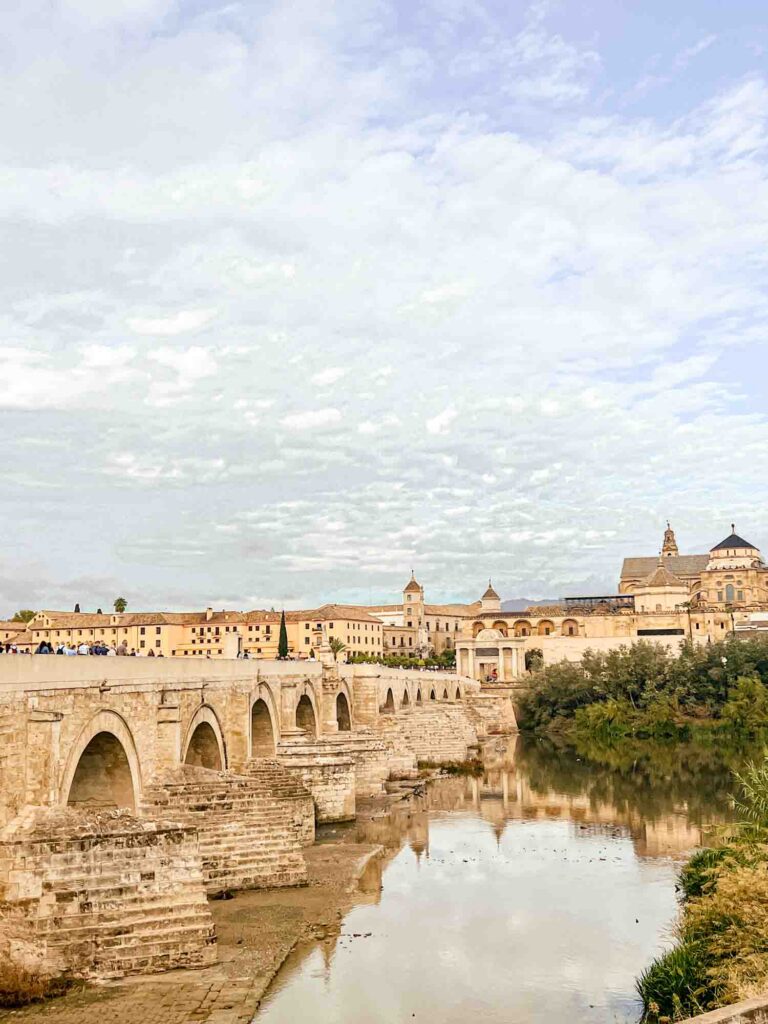
Roman Bridge
After the Mezquita, walk a few minutes towards the river to the Roman Bridge. The bridge was built in 1 BC, although most of the present day structure was constructed by the Moors in the 8th century.
The bridge is an impressive site, featuring 16 arches and stretching 247 meters across. It’s super photogenic, and was even used as the Long Bridge of Volantis on Game of Thrones (although it was enhanced with CGI).

Roman Temple
The bridge isn’t the only Roman landmark in Cordoba – there’s a temple as well. The city was home to a number of temples during Roman times, but this was the only one to be discovered through archaeological excavation.
The temple dates back to 1AD, and was found during an expansion of the City Hall in the 1950s. Only a few columns remain now, but it was once a massive temple that can be seen for miles.

Plaza de la Corredera
One of the most iconic squares in Cordoba, Plaza de la Corredera features a number of picturesque arcades painted in a pretty shade of red and yellow. It was once home to a town hall and prison and was the site of many public spectacles, including bullfights, during the Spanish Inquisition.
Today, it’s home to apartments, shops, restaurants, shops, and cafes, many of which have outdoor seating within the square.


Jewish Quarter
Cordoba was home to a thriving Jewish population from the 10th to 15th century who lived in this quarter. This area of Cordoba is filled with winding, narrow streets, all oozing with charm. The entire area is designated a UNESCO World Heritage site and it’s easy to see why.
I enjoyed just walking through the streets here and snapping tons of photos, including of the charming Calleja de los Flores, perhaps the most famous street in Cordoba with hundreds of flower pots hanging on either side.
The Jewish Quarter is also home to the only remaining synagogue in Andalucia, which is free to visit and also worth popping into.


Alcazar de los Reyes Cristianos
Cordoba’s Alcazar is not nearly as spectacular as Seville’s Royal Alcazar. However, it’s one of the most important historical sites in the city and well worth a visit. The palace is built in the Mudejar style, and has some beautiful gardens that are miniature versions of the ones at the Alhambra.
The Alcazar de los Reyes Cristianos served as a residence and political headquarters for Christian monarch. Most notably, this is where King Ferdinand and Queen Isabella planned the Inquisition. It is also where they first met with Christopher Columbus as he planned his voyage to the Americas.


Tour the city’s patios
One of the most unique things about Cordoba are its floral patios. Every spring, the city hosts the Fiesta de los Patios, in which residents decorate their patios with a spectacular display of flowers, plants, fountains, and mosaics and compete to be the most beautiful.
These patios, while pretty and photo-worthy, actually are super practical – they’re a cooling mechanism because Cordoba gets so hot.
Even if you aren’t visiting during the festival, you can tour the patios. Simply head to the San Basillo neighborhood and you’ll find signs advertising patios. However, I suggest taking a tour so you can hit up the most notable ones and hear more about them.


Traveling from Cordoba to Granada
After spending the day in Cordoba, it’s time to head to Granada for the last stop on this Barcelona + Seville + Granada itinerary
The best way to get to Granada is by train. Depending on your evening plans and whether you want to eat dinner in Cordoba or Granada, you can either take a train that departs at 4:21 or 8:10. The trip takes 1.5-2 hours, depending on if you take an AVE or regional train.
Granada’s train station is located 3 kilometers from the city center – you can take a taxi or bus to get to your accommodations.
Do note that the trains operate on a dynamic pricing system, so book your tickets ASAP! Use Omio to book your tickets as this will save you a lot of time and hassle over figuring out the Renfe website.
Other ways to get to Granada are by Alsa bus (2 hours, 45 minutes) or driving (2 hours, 15 minutes)
Barcelona and Andalucia Itinerary Days 8-9: Granada

Time for the last city on your Spain in 10 days itinerary – Granada!
Granada is one of the most fascinating cities in Spain. It’s best known for the stunning Alhambra palace and gardens, but it is so much more than that. The city plays such a significant role in Spain’s history that it is a must visit. It’s kinda like a piece in a puzzle – you gotta visit it so the rest of it makes sense.
Not only that, it’s absolutely beautiful – located at the foothills of the Sierra Nevada mountains, the city is filled with charming streets and picturesque Moorish buildings that won’t fail to draw you in and make you fall in love.
Some say it captures the essence of Spain, with its rich history, vibrant culture, and all-around beauty.


Where to stay in Granada
I recommend staying near the historic center of Granada, which will give you easy access to pretty much everywhere you need to go. Some suggest staying in the picturesque Albaicin district, but do note that this area is VERY hilly.
Here are some of my picks for where to stay in Granada:
- Room Mate Leo: This is where we stayed, and I enjoyed the recently renovated rooms with rich decor inspired by the Alhambra. There’s also a rooftop terrace with a view of the Alhambra! It’s also located in the heart of the historic center and getting around was a breeze. However, I would avoid staying here on the weekends as you can hear all the noise from the streets and it stays noisy well into the middle of the night.
- Hotel Casa 1800: This boutique hotel is BEAUTIFUL and staying here will make you feel like royalty! The decor features some ornate elements such as a canopy bed and crystal chandeliers. There’s a pretty courtyard as well. The location is right in between the historic center and Albaicin, which makes it super convenient to get to both.
- Gar Anat Hotel Boutique: This cozy property plays off Granada’s architectural spirit, with brightly decorated rooms, along with a courtyard inspired by the Alhambra. You can’t beat the locations, just a short walk to many of the top sights. The rates are pretty affordable as well.
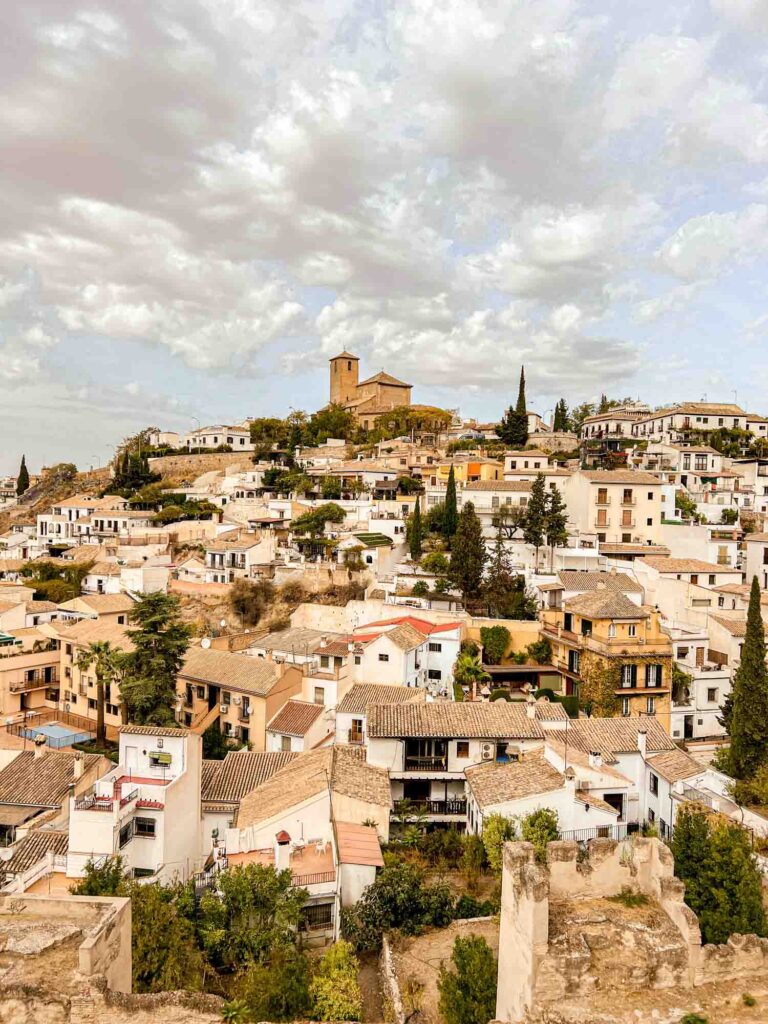

Getting around in Granada
- Walking: Most of Granada’s top attractions are located relatively close to each other, making it easy to get around on foot. I walked to get around during my stay in Granada.
- Bus: While Granada is fairly easy to get around on foot, parts of the city are quite hilly and can be a bit of a hike to reach. If you don’t want to deal with those hills, there is a network of red, white, and green mini buses that stop at all the top sights in the historic center, Albaicin, Sacromonte, and even the Alhambra. Here is the route information and schedules.
- Taxi: Taxi service is available all around Granada. You can either go to a taxi stand, or hail one on the street. There are three tiers of fares for weekday, weekend/holiday, and nighttime rates.
Day 8: Granada


Granada Cathedral + Royal Chapel
I know, I know – there’s a few churches included on this Barcelona + Seville + Granada itinerary, and at this point you might churched out and tempted to skip these. I was too, until a tour guide convinced me otherwise.
The Granada Cathedral stands in the heart of the city’s historic center, on the site of where the Great Mosque once stood. The cathedral has a mix of Gothic, Renaissance, and Baroque styles. What sets it apart is the stunning white marble interior, and the altar and its cupola are one of the most beautiful I’ve seen!
Located across from the Cathedral, the Royal Chapel is the final resting place for King Ferdinand and Queen Isabella, the first Catholic monarchs of Spain. Their children, Joana and Phillip, are also buried here.


Alcaiceria
This series of narrow alleyways was once home of the Moorish silk market or the Grand Bazaar. It dates back to the 15th century, but unfortunately was destroyed by a fire in the 18th century and only one street remains.
The Alcaiceria still has a distinctive Moorish feel today, and you’ll find the street lined with tons of vendors selling middle eastern-themed goods, Spanish tiles, postcards, and other goods. It’s a good place to shop for some souvenirs – or just wander through.

Plaza Nueva
Plaza Nueva is the oldest square in Granada, built to create space and cover the Darrio river, which flows underneath the square. It separates the old town from the Carrera del Darro, which leads to the Albaicin district.
I loved the colorful buildings surrounding the square, as well as the view of the Alhambra peeking out behind them on top of the hill. There’s usually a flurry of activity here, and it’s a fun spot to do some people watching.


Explore the Albaicin
The historic Albaicin district is one of Granada’s most charming areas, filled with whitewashed buildings and narrow cobblestone streets. It’s also steeped in history – it was once the Arab Quarter in the city. To get a bit of historical context, I highly recommend you take a walking tour.


You can literally get lost in the maze of picturesque streets for hours, but here are some highlights of the Albaicin to check out while exploring the neighborhood:
- Carrera del Darro: This street runs along the left bank of the Darro river and is one of the most picturesque streets in the city, with some of the city’s oldest houses.
- El Bañuelo: One of the most well-preserved Muslim baths in the area, dating back to the 11th century.
- Palacio de Dar Al-Horra: The only Moorish palace still standing here, which used to be the home of the ruling family’s palace before it was moved to the Alhambra under a new ruling family.
- Tea houses: Calderería Nueva is dotted with traditional Moorish tea houses, which are perfect for stopping for a break.

Mirador de San Nicolas
*THE* most popular viewpoint in Granada and it’s easy to see why – Mirador de San Nicolas is located directly across from the Alhambra, so you get a picture perfect view of it.
It’s an especially popular spot for sunset, and even Bill Clinton even declared it to have the “best sunset in the world.”
Expect lots of crowds, especially at sunset, but really throughout the day. You might have to fight some self stick-wielding tourists for a spot, but the view really is spectacular from here.
For dinner, I suggest heading back down to the historic center and eating at Restaurante Palacio Andaluz Almona for some amazing Moroccan food!
Day 9: Granada
This day of your Barcelona and Andalucia itinerary is mostly devoted to one of Spain’s most well-known monuments – the Alhambra!

Alhambra
The Alhambra needs no introduction – it’s the most famous attraction in Granada and one of the most visited in Spain (it alternates back and forth between the Alhambra and Sagrada Familia for the most and second most visited, in fact).
The Alhambra is beautiful, fascinating, and steeped in history and is an absolute must-visit when in Granada. I recommend devoting at least a half day to exploring the Alhambra – there’s much to see here!



Book your tickets as soon as you decide you’re going to Granada. This is very, VERY important, as tickets usually sell out weeks in advance! This is especially important if you want to see the Nasrid Palaces. Even in October, by the time we finalized this Barcelona and Southern Spain itinerary two weeks before our trip, the Nasrid Palace tickets were sold out.
So what do you do? Another option is to book a guided tour, but double check to see that the tour actually includes admission into the Nasrid Palaces (like this one) because not all of them do. I failed at this and ended up booking a tour that only included the Alcazaba, gardens, and the Generalife.
Still, I thought the tour was very well worth it and found it so interesting – learning so much about the history of the Alhambra, Granada, and Andalucia itself added SO much context to my visit. Even if you don’t get to visit the Nasrid Palaces, I still highly recommend visiting the Alhambra and do suggest doing a tour (here is the exact one I did).
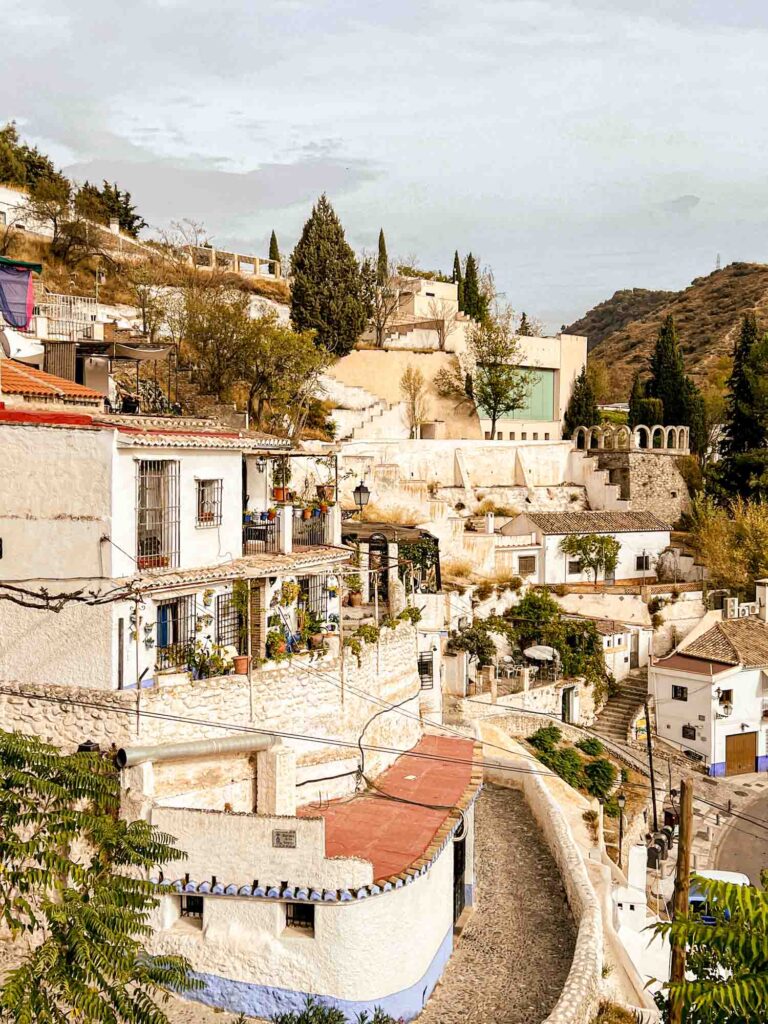
Sacromonte
After spending the morning exploring the Alhambra, it is time to explore one of Granada’s most fascinating neighborhoods – Sacromonte.
Sacromonte was traditionally the Roma (or gypsy) quarter of Granada, where they were forced to settle because they were not allowed to live in the city itself. It is mostly known for its cave dwellings, which are partially or completely dug into caves dug into the side of the cliffs here.


While most people live in actual houses today, you can still see some cave dwellings in the neighborhood today. Some of them have been converted into tapas restaurants or flamenco theaters (seeing a flamenco show here is one of the most popular things to do in Granada). Some still live in the dwellings high up in the hills, without electricity or running water.
For a fascinating look into life here, check out the Museo Cuevas de Sacromonte, or the cave museum. Here, you’ll find recreated examples of the cave dwellings to show how people lived and worked in them.


Go on a tapas crawl
Time to tapear! One of the most unique things about Granada is that you get free tapas when ordering a drink – yes, FREE!
This is true in most of the city’s tapas restaurants, although there are a few that don’t do this. You don’t even have to order an alcoholic drink – you still get a free tapa when you order a soft drink or a bottle of water.
A fun way to spend the night is to hop around to all the tapas bars in the city, and sample all of its offerings! Here are some of the spots that I recommend:
Be sure to also read my 2 days in Granada itinerary, which is packed with much more tips and advice on what to do + see there!
End of your Barcelona + Seville + Granada Itinerary


Day 10: End of your 10 days in Spain itinerary
We’ve now come to the end of your 10 days in Barcelona and Southern Spain itinerary – insert sad face here. What you do on this last day will depend on your travel plans.
While you can fly back home from Granada or even Seville, you’ll find that flights are cheaper and more abundant out of one of the bigger cities in Spain, like Barcelona or Madrid.
Since our flights were in and out of Barcelona, we spent the last day of our 10 day trip to Spain traveling back to Barcelona. It takes about six hours to travel from Granada to Barcelona. We took a morning train, so we had another half day to spend in the city.
Have you ever been to Spain? What would you include on your Spain in 10 days itinerary?
More Spain content you may enjoy:
3 days in Barcelona: The Perfect Itinerary
2 Days in Seville Itinerary
The Perfect 2 Days in Granada
Most Instagrammable Places in Barcelona
Liked this post? Save this 10 days in Barcelona and Southern Spain itinerary on Pinterest for later!


Caroline is a Southern California based traveler, writer, and photographer. She travels all around California, the US, and the world in search of the most colorful places, the most delicious food, and bucket-list adventures. Her aim is to inspire other travelers discover how to add more adventure and joy to their lives. On Pictures & Words, you’ll find detailed guides + itineraries, along with vibrant photos to help you plan the the most epic trips. When she’s not traveling, Caroline also runs half marathons.
